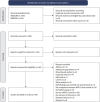Non-alcoholic fatty liver disease increases risk of carotid atherosclerosis and ischemic stroke: An updated meta-analysis with 135,602 individuals
- PMID: 35232007
- PMCID: PMC9293613
- DOI: 10.3350/cmh.2021.0406
Non-alcoholic fatty liver disease increases risk of carotid atherosclerosis and ischemic stroke: An updated meta-analysis with 135,602 individuals
Abstract
Background/aims: Non-alcoholic fatty liver disease (NAFLD) is associated with the development of cardiovascular disease. While existing studies have examined cardiac remodeling in NAFLD, there has been less emphasis on the development of carotid atherosclerosis and stroke. We sought to conduct a meta-analysis to quantify the prevalence, risk factors, and degree of risk increment of carotid atherosclerosis and stroke in NAFLD.
Methods: Embase and Medline were searched for articles relating to NAFLD, carotid atherosclerosis, and stroke. Proportional data was analysed using a generalized linear mixed model. Pairwise meta-analysis was conducted to obtain odds ratio or weighted mean difference for comparison between patients with and without NAFLD.
Results: From pooled analysis of 30 studies involving 7,951 patients with NAFLD, 35.02% (95% confidence interval [CI], 27.36-43.53%) had carotid atherosclerosis with an odds ratio of 3.20 (95% CI, 2.37-4.32; P<0.0001). Pooled analysis of 25,839 patients with NAFLD found the prevalence of stroke to be 5.04% (95% CI, 2.74-9.09%) with an odds ratio of 1.88 (95% CI, 1.23-2.88; P=0.02) compared to non-NAFLD. The degree of steatosis assessed by ultrasonography in NAFLD was closely associated with risk of carotid atherosclerosis and stroke. Older age significantly increased the risk of developing carotid atherosclerosis, but not stroke in NAFLD.
Conclusion: This meta-analysis shows that a stepwise increment of steatosis of NAFLD can significantly increase the risk of carotid atherosclerosis and stroke development in NAFLD. Patients more than a third sufferred from carotid atherosclerosis and routine assessment of carotid atherosclerosis is quintessential in NAFLD.
Keywords: Atherosclerosis; Ischemic stroke; Nonalcoholic fatty liver disease; Stroke.
Conflict of interest statement
AJS is President of Sanyal Biotechnology and has stock options in Genfit, Akarna, Tiziana, Indalo, Durect and Galmed. He has served as a consultant to Astra Zeneca, Nitto Denko, Enyo, Ardelyx, Conatus, Nimbus, Amarin, Salix, Tobira, Takeda, Jannsen, Gilead, Terns, Birdrock, Merck, Valeant, Boehringer-Ingelheim, Lilly, Hemoshear, Zafgen, Novartis, Novo Nordisk, Pfizer, Exhalenz and Genfit. He has been an unpaid consultant to Intercept, Echosens, Immuron, Galectin, Fractyl, Syntlogic, Affimune, Chemomab, Zydus, Nordic Bioscience, Albireo, Prosciento, Surrozen and Bristol Myers Squibb. His institution has received grant support from Gilead, Salix, Tobira, Bristol Myers, Shire, Intercept, Merck, Astra Zeneca, Malinckrodt, Cumberland and Norvatis. He receives royalties from Elsevier and UptoDate. MN has been on the advisory board for 89BIO, Gilead, Intercept, Pfizer, Novo Nordisk, Blade, EchoSens, Fractyl, Terns, Siemens and Roche diagnostic; MN has received research support from Allergan, BMS, Gilead, Galmed, Galectin, Genfit, Conatus, Enanta, Madrigal, Novartis, Pfizer, Shire, Viking and Zydus; MN is a minor shareholder or has stocks in Anaetos, Rivus Pharma and Viking.
All other authors do not have any conflict of interest to declare.
Figures
Comment in
-
Does nonalcoholic fatty liver disease predispose patients to carotid arteriosclerosis and ischemic stroke?Clin Mol Hepatol. 2022 Jul;28(3):473-477. doi: 10.3350/cmh.2022.0155. Epub 2022 Jun 22. Clin Mol Hepatol. 2022. PMID: 35730209 Free PMC article. No abstract available.
Similar articles
-
Elevated concurrent carotid atherosclerosis rates in patients with metabolic dysfunction-associated fatty liver disease (MAFLD) compared to non-alcoholic fatty liver disease (NAFLD): A cross-sectional observational study.Nutr Metab Cardiovasc Dis. 2025 Jan;35(1):103767. doi: 10.1016/j.numecd.2024.10.006. Epub 2024 Oct 9. Nutr Metab Cardiovasc Dis. 2025. PMID: 39561692
-
Nonalcoholic Fatty Liver Disease for Identification of Preclinical Carotid Atherosclerosis.Medicine (Baltimore). 2016 Jan;95(3):e2578. doi: 10.1097/MD.0000000000002578. Medicine (Baltimore). 2016. PMID: 26817915 Free PMC article.
-
Non-alcoholic fatty liver disease: A new predictor of recurrent ischemic stroke and transient ischemic attack in patients with carotid atherosclerosis.Eur J Radiol. 2024 Dec;181:111754. doi: 10.1016/j.ejrad.2024.111754. Epub 2024 Sep 23. Eur J Radiol. 2024. PMID: 39341166
-
Nonalcoholic fatty liver disease and carotid artery atherosclerosis in children and adults: a meta-analysis.Eur J Gastroenterol Hepatol. 2015 Nov;27(11):1237-48. doi: 10.1097/MEG.0000000000000429. Eur J Gastroenterol Hepatol. 2015. PMID: 26193052 Review.
-
A Meta-Analysis on the Global Prevalence, Risk factors and Screening of Coronary Heart Disease in Nonalcoholic Fatty Liver Disease.Clin Gastroenterol Hepatol. 2022 Nov;20(11):2462-2473.e10. doi: 10.1016/j.cgh.2021.09.021. Epub 2021 Sep 22. Clin Gastroenterol Hepatol. 2022. PMID: 34560278 Review.
Cited by
-
Guideline for the Prevention and Treatment of Metabolic Dysfunction-associated Fatty Liver Disease (Version 2024).J Clin Transl Hepatol. 2024 Nov 28;12(11):955-974. doi: 10.14218/JCTH.2024.00311. Epub 2024 Nov 4. J Clin Transl Hepatol. 2024. PMID: 39544247 Free PMC article.
-
Clinical Management of Non-alcoholic Steatohepatitis and the Role of the Cardiologist.Eur Cardiol. 2023 Dec 22;18:e64. doi: 10.15420/ecr.2023.22. eCollection 2023. Eur Cardiol. 2023. PMID: 38213666 Free PMC article.
-
Modulatory effect of camel milk on intestinal microbiota of mice with non-alcoholic fatty liver disease.Front Nutr. 2022 Dec 1;9:1072133. doi: 10.3389/fnut.2022.1072133. eCollection 2022. Front Nutr. 2022. PMID: 36532537 Free PMC article.
-
The effect of diabetes and prediabetes on the prevalence, complications and mortality in nonalcoholic fatty liver disease.Clin Mol Hepatol. 2022 Jul;28(3):565-574. doi: 10.3350/cmh.2022.0096. Epub 2022 May 19. Clin Mol Hepatol. 2022. PMID: 35585687 Free PMC article.
-
Hypertension is prevalent in non-alcoholic fatty liver disease and increases all-cause and cardiovascular mortality.Front Cardiovasc Med. 2022 Aug 8;9:942753. doi: 10.3389/fcvm.2022.942753. eCollection 2022. Front Cardiovasc Med. 2022. PMID: 36003916 Free PMC article.
References
-
- Lim GEH, Tang A, Ng CH, Chin YH, Lim WH, Tan DJH, et al. An observational data meta-analysis on the differences in prevalence and risk factors between MAFLD vs NAFLD. Clin Gastroenterol Hepatol. 2021 Dec 4; doi: 10.1016/j.cgh.2021.11.038. - PubMed
-
- Chalasani N, Younossi Z, Lavine JE, Charlton M, Cusi K, Rinella M, et al. The diagnosis and management of nonalcoholic fatty liver disease: practice guidance from the American Association for the Study of Liver Diseases. Hepatology. 2018;67:328–357. - PubMed
Publication types
MeSH terms
LinkOut - more resources
Full Text Sources
Medical





